Harp seal
Pagophilus groenlandicus
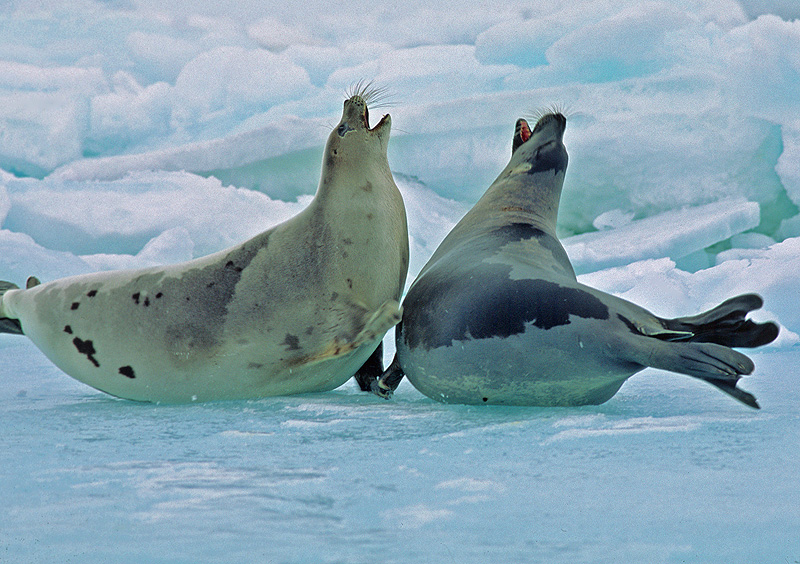
Greenland seals on the breeding field at Newfoundland. To the left a young (probably first-time mother) with incipient black side. To the right an old one with a large black field on the side (black side). Photo: Aqqalu Rosing-Asvid.
Size
The harp seal is a medium-sized seal. Young individuals (blue sides) are speckled, but around puberty they get a black marking on the back (they turn into black sides). Adult males grow on average about 1.70 m, females approx. 5 cm shorter. However, there is some variation and the largest individuals grow up to 2.00 m. The first adult seals that arrive in West Greenland in mid-May from the breeding / moulting field at Newfoundland weigh about 80-90 kg. They eat fat all summer and autumn, and just before the breeding season, which starts in February, the males weigh on average around 145 kg and the females around 130 kg.
Food
The food along the west coast of Greenland up to Upernavik consists mainly of capelin (ammassat), supplemented with krill and various small fish. At the fish banks in the outlying areas, the relatively few stomachs collected suggest that sand eel is a very important food. North of Upernavik, the harp seal most often eats polar cod, supplemented with themisto (a kind of seaweed flea that lives up in the water – see picture under ringed seal). The choice of food along the coast of East Greenland is not known in detail, but the stomachs that have been examined indicate that the most important species, as on the west coast, are capelin, krill and polar cod and themisto, which make up the main food.
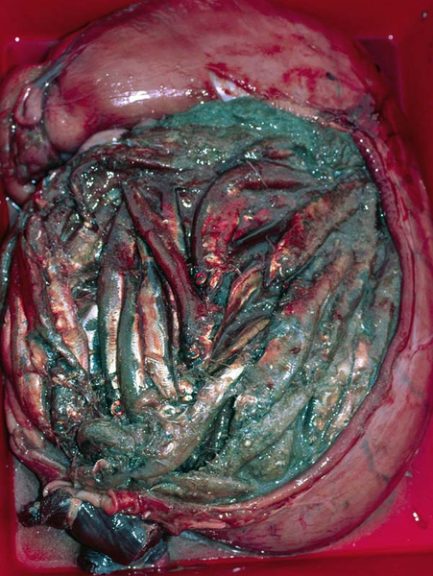
A harp seal’s stomach contents with its favourite food, capelin. Photo: Aqqalu Rosing-Asvid.
Reproduction
During the winter, almost all the adult harp seals congregate in three areas where they give birth to their young (see distribution and number). The harp seal usually becomes sexually mature around the age of 5, but significantly later sexual maturation has been found in the easternmost harp seals during periods with few lots. The pups are born at Newfoundland and in the White Sea from late February to early March. Births in the Greenland Sea usually do not start until the second half of March. At birth, the young are approx. 80 cm long, and weighs about 10 kg. They usually suckle for approx. 10-12 days, and during this period gain a little over 2 kg per day. Mating usually takes place immediately after the lactation period. The fertilized egg sometimes divides and goes to sleep. Only around the end of July or the beginning of August does the egg attach itself to the uterus (it is implanted) and fetal development begins.
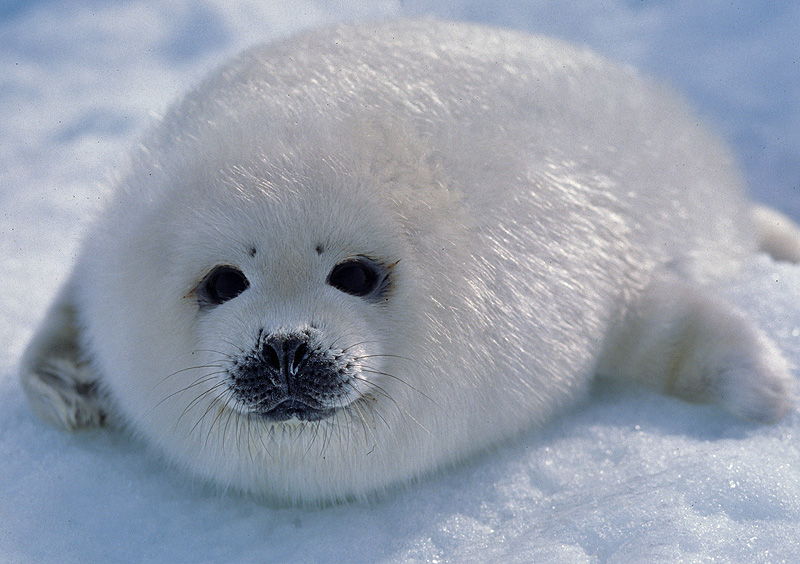
Harp seal pup (whitecoat). Photo: Aqqalu Rosing-Asvid.
Moulting
When the mating season is over, males and young animals first gather in large concentrations to shed. The females will often forage for a few weeks before starting to shed (changing the hairs).
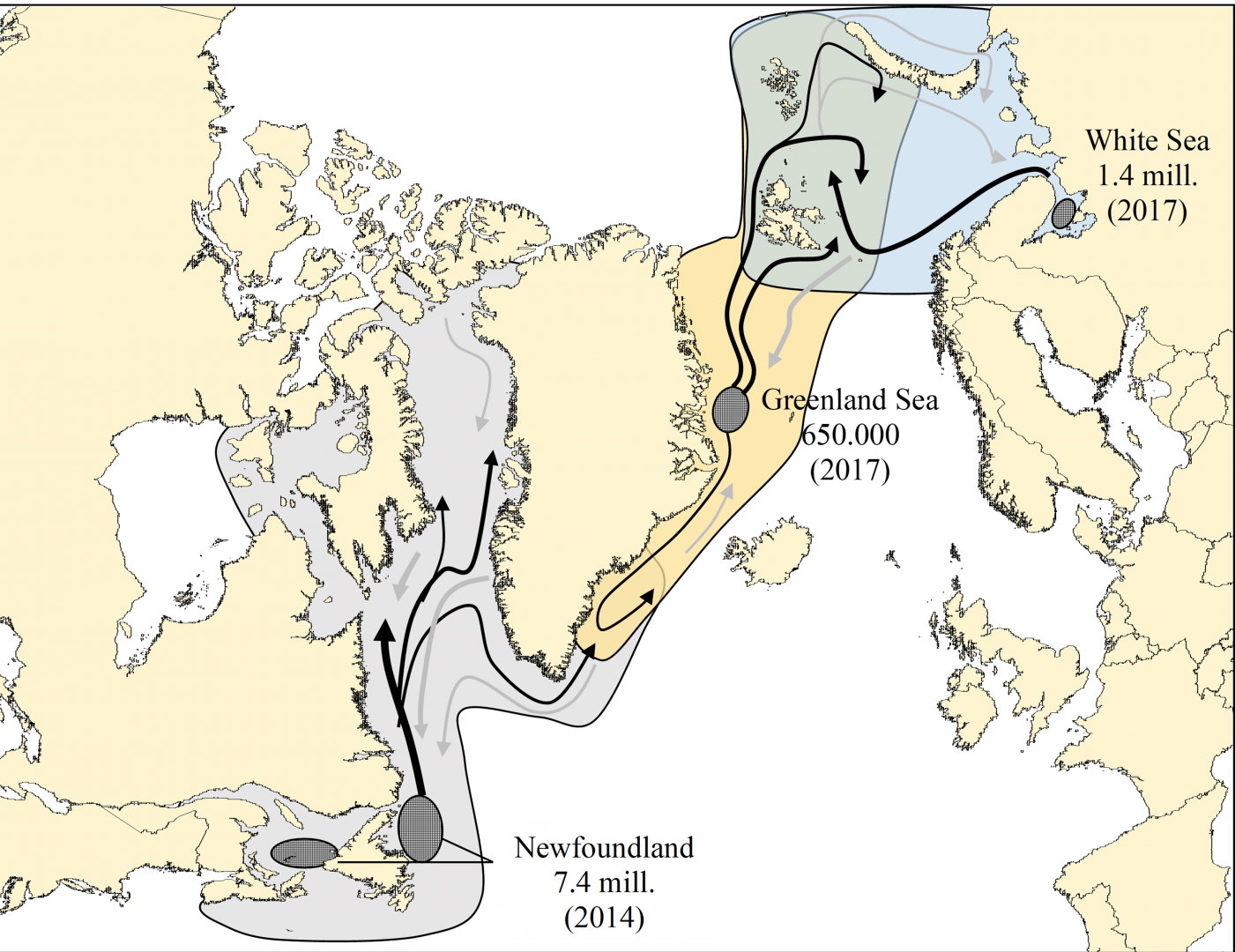
Distribution and numbers
When the harp seals have finished shedding, it is important to rebuild the fat depots so that they can cope with the next breeding and shedding period. At Newfoundland, the males first finish the moulting, and together with the yearlings, which do not have to shed, they arrive in West Greenland around the middle of May. During June-July, the females also appear, and throughout the summer, young and adult harp seals spread northwards, both along the coast and offshore in Baffin Bay. Some will also swim south of Greenland and a little up the east coast, where they can meet other harp seals that were born on the breeding field in the Greenland Sea. Most of the seals from the Greenland Sea will in the summer spread northeast to the Barents Sea, where they mix the seals that were born on the breeding field in the White Sea. The harp seals seek back against their breeding grounds again in the winter as the ice spreads again. However, a few animals overwinter along the coasts of southwest Greenland.
The traditional breeding areas may move slightly from year to year depending on the ice conditions, but since they were discovered in the 18th century, the overall location has remained relatively unchanged. In 2007, however, it was found that in southwestern Greenland, several hundred newly weaned cubs arrived, who still had white hair (whitecoats). They were transported by ice up to Qaqortoq, and since then such whitecoats have been seen several times on the stretch between Cape Farewell and Arsuk. These observations indicate that there is now also a small group (much smaller than the traditional groups) that give birth to their young on the ice in Southeast Greenland.
Status
The commercial capture of harp seals started as early as the 1720s on the breeding field in the Greenland Sea and around the 1760s off Newfoundland. Catches in these fields peaked in the mid-19th century, but then declined gradually, due to overexploitation which reduced stocks. In the early 1970s, the population at Newfoundland was reduced to approx. 1 million individuals. Since then, catch regulations and sharply reduced sealskin prices, as a result of a massive campaign against seal hunting in the 1980s, have reduced catches, and therefore stocks have grown significantly.
The strong growth of the population at Newfoundland stopped around 2008, and since then the population has stabilized around 7-8 million seals. The total Greenlandic-Canadian catch of this stock has since 2008 averaged approx. 135,000 / year with approx. equal catches in each country. However, this catch has virtually no effect on the development of the population, which is now mainly regulated by the seals’ own condition and reproduction. For example, in 2008 approx. 1.6 million pups at Newfoundland, whereas in 2012 only approx. 800,000 seals.
The population that breeds in the Greenland Sea is also believed to have grown slightly since the 1970s, but far from as much as the population at Newfoundland. The current stock estimate for this stock is approx. 650,000 seals.
Consultancy and management
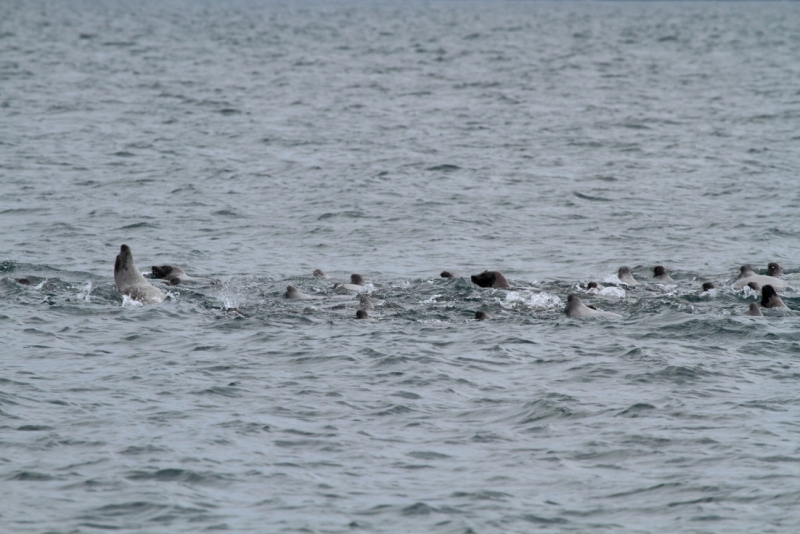
Adult harp seals most often forage in flocks in summer and autumn. The food will then usually consist of capelin in southwestern Greenland and polar cod in northwestern Greenland. Photo: Aqqalu Rosing-Asvid.
Advice on sustainable exploitation of harp seals is given by a working group, under ICES / NAFO / NAMMCO. The working group consists of researchers from Norway, Canada, Greenland and Russia. The stocks are monitored in different ways (see more under research), and on that basis recommendations are given for sustainable hunting. As the stock at Newfoundland is believed to be around its maximum level, this stock can be managed for ecological or socio-economic reasons. For example, the quota can be increased depending on the skin prices, and the stock can be reduced as long as it is not reduced to less than 70% of the maximum stock. If the stock falls below this level, a management plan must be initiated with the aim of getting the stock above 70% again. The stock in the Greenland Sea may be slightly below 70%, and therefore quotas are calculated that allow growth in this stock.
Research
The populations of harp seals are monitored by approx. every five years counts the number of pups born on the breeding grounds. To convert this to the total number of seals in the population, one keeps an eye on how old the females are when they reach sexual maturity, and how large a proportion of the sexually mature females have a young. As the population at Newfoundland was greatly reduced, the seals became sexually mature early, and almost all adult females gave birth to young. Now that the population is large, the average seal later becomes sexually mature, and the estimate of the proportion of females giving birth to a young has varied between 20-86% over the last decade. This is partly due to that some of the seals (especially the leanest) often abort, perhaps because they are not fat enough to be able to give their young the fat they need to survive. So when in 2012 only approx. half as many pups as in 2008, it is not because there have been fewer adult seals, but because the seals were in poorer condition, so many aborted and fewer pups were born.
The estimate of the number of newborn chicks is entered into a model together with data on the females’ reproduction, catch size and age composition, as well as the proportion of chicks that die early as a result of poor ice on the breeding grounds. In this way, a new figure for the stock is estimated. The mortality and reproduction data that come into the model can also be used to estimate how many pups will be born. The counts that are made should therefore preferably match what the model predicts, as it shows that you probably have the right numbers. For example, it was expected that in 2012 significantly fewer pups would be counted than in 2008, as it could be seen that many of the females who arrived in the maternity area in 2012 were not pregnant. In this way, the counts have for many years given estimates that could be reasonably expected. However, the latest estimate (from 2017) has been somewhat lower than expected. This indicates that there are errors in either the numbers you have for reproduction and mortality or in an error in the count itself. What it is, has not yet been clarified, and therefore a new stock estimate has not been made after the census in 2017. The same problem has arisen for the other two stocks, and work is therefore being done to find out what has been changed.

